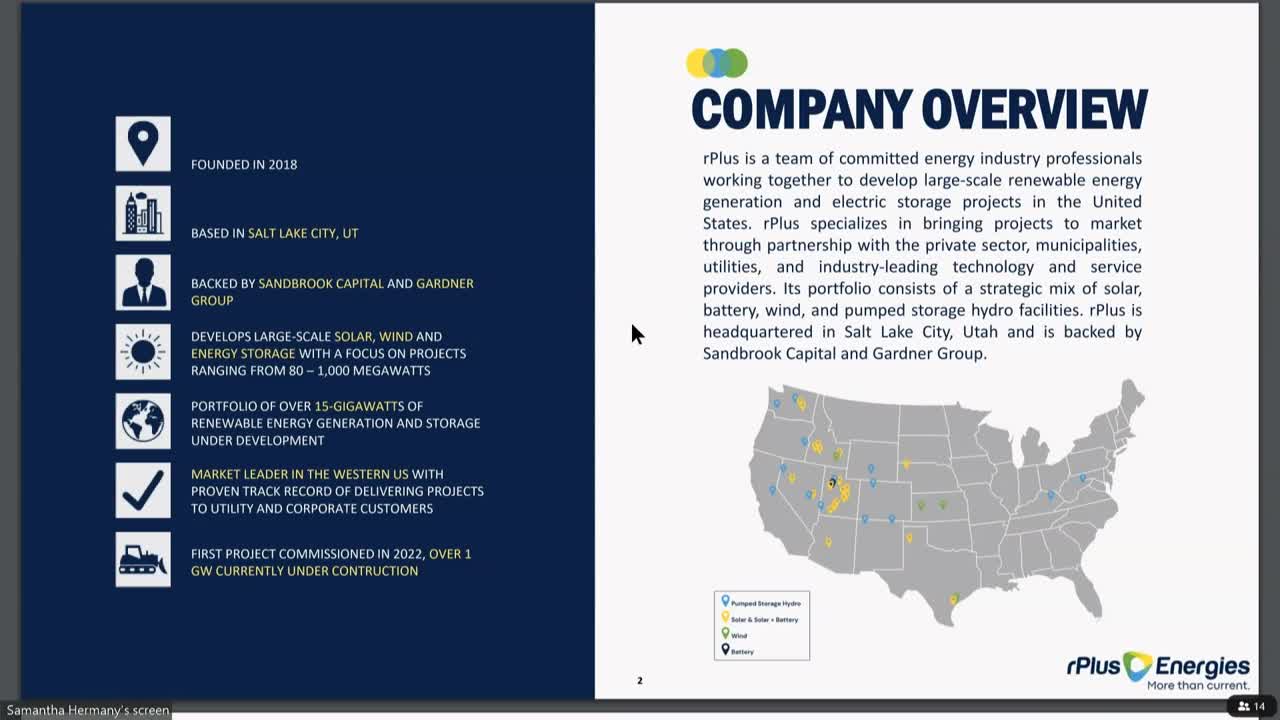Green River Energy Center set to transform Utah's energy landscape
October 16, 2024 | Utah Interim, Utah Legislative Branch, Utah
This article was created by AI summarizing key points discussed. AI makes mistakes, so for full details and context, please refer to the video of the full meeting. Please report any errors so we can fix them. Report an error »

In the heart of Utah's bustling energy landscape, a pivotal meeting unfolded on October 16, 2024, as the Public Utilities, Energy, and Technology Interim Committee gathered to discuss the future of energy development in the state. The atmosphere was charged with anticipation as representatives from R Plus, a key player in renewable energy, presented their ambitious plans for the Green River Energy Center, a groundbreaking solar and battery project poised to reshape the region's energy profile.
The committee was informed that the Green River Energy Center, located in Emery County, will feature an impressive 400 megawatts of solar power coupled with 400 megawatts of battery storage. With a staggering capital investment of $1.1 billion, this project is not only the largest of its kind currently under construction in the United States but also a significant milestone for Utah's energy sector. The project is expected to go online in May 2026, following eight years of meticulous planning and development.
R Plus highlighted the project's potential to invigorate local economies, projecting the creation of approximately 500 construction jobs at its peak and 15 to 20 permanent positions once operational. The anticipated increase in property tax revenue—estimated at $4.3 million in the first year and $55 million over the project's lifespan—will bolster the Emery County tax base and support community initiatives, including affordable housing.
The meeting also underscored the importance of collaboration between state leaders and energy developers. R Plus expressed its commitment to supporting Utah's Operation Gigawatt initiative, which aims to enhance the state's energy capacity amid growing demand. The company emphasized the role of solar and battery technology in this effort, citing advancements in lithium-ion technology as a key factor in meeting future energy needs.
As the discussion progressed, committee members raised questions about the project's land use and operational specifics. R Plus confirmed that the entire project will be situated on private land, ensuring a streamlined development process. The energy storage capabilities of the facility were also clarified, with the batteries able to dispatch power up to 360 times a year, providing a reliable energy source for the grid.
This meeting not only highlighted the ambitious plans for the Green River Energy Center but also reflected a broader commitment to sustainable energy solutions in Utah. As the state navigates its energy future, projects like this one are set to play a crucial role in ensuring economic competitiveness and environmental stewardship. The committee's discussions signal a promising path forward, one where innovation and collaboration can drive Utah's energy landscape into a new era.
The committee was informed that the Green River Energy Center, located in Emery County, will feature an impressive 400 megawatts of solar power coupled with 400 megawatts of battery storage. With a staggering capital investment of $1.1 billion, this project is not only the largest of its kind currently under construction in the United States but also a significant milestone for Utah's energy sector. The project is expected to go online in May 2026, following eight years of meticulous planning and development.
R Plus highlighted the project's potential to invigorate local economies, projecting the creation of approximately 500 construction jobs at its peak and 15 to 20 permanent positions once operational. The anticipated increase in property tax revenue—estimated at $4.3 million in the first year and $55 million over the project's lifespan—will bolster the Emery County tax base and support community initiatives, including affordable housing.
The meeting also underscored the importance of collaboration between state leaders and energy developers. R Plus expressed its commitment to supporting Utah's Operation Gigawatt initiative, which aims to enhance the state's energy capacity amid growing demand. The company emphasized the role of solar and battery technology in this effort, citing advancements in lithium-ion technology as a key factor in meeting future energy needs.
As the discussion progressed, committee members raised questions about the project's land use and operational specifics. R Plus confirmed that the entire project will be situated on private land, ensuring a streamlined development process. The energy storage capabilities of the facility were also clarified, with the batteries able to dispatch power up to 360 times a year, providing a reliable energy source for the grid.
This meeting not only highlighted the ambitious plans for the Green River Energy Center but also reflected a broader commitment to sustainable energy solutions in Utah. As the state navigates its energy future, projects like this one are set to play a crucial role in ensuring economic competitiveness and environmental stewardship. The committee's discussions signal a promising path forward, one where innovation and collaboration can drive Utah's energy landscape into a new era.
View full meeting
This article is based on a recent meeting—watch the full video and explore the complete transcript for deeper insights into the discussion.
View full meeting

